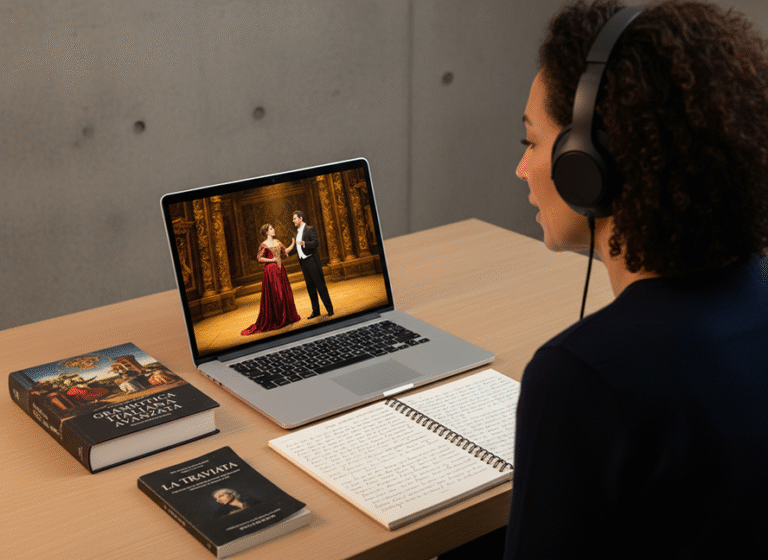
How Italian opera can unlock your C1 fluency: the active listening method.
Beyond grammar: use the art of opera to master sophisticated vocabulary, complex structures, and the dramatic diction necessary for a true advanced level (C1).
Do you like it? Share the article.
1. The C1 challenge: not just knowing, but acting in Italian.
Reaching the C1 level doesn’t just mean knowing Italian; it means being it in every context. Standard textbooks stop where the real challenge begins: mastering a formal linguistic register, fluently using implicit subordinate clauses, and assimilating specialized vocabulary.
For your preparation, there’s no more powerful tool than opera. Opera is a linguistic gym that combines:
Sophisticated and historical vocabulary: Vocabulary ranging from politics to philosophy.
Complex syntactic structures: Perfect for exercising your ability to handle third-degree hypothetical periods and formal constructs.
Dramatic diction and intonation: Ideal for refining your pronunciation in an elegant and authoritative manner.
2. From Scene to Lexicon: Analyzing Melodrama.
Our approach is not limited to listening. It is based on active listening, which transforms an artistic performance into an intensive C1 lesson.
| Method Phase | Linguistic Action | C1 Objective |
| Passive Listening | Enjoy the opera with Italian subtitles to grasp the plot. | Global understanding. |
| Libretto Analysis | Isolate and analyze the most complex arias or recitatives (e.g., Verdi, Puccini). | Identification of verbs and formal structures (e.g., imperfect subjunctive, past remote). |
| Diction Study | Re-listen to isolated parts focusing on the singers’ pronunciation. | Imitation of cadence and vowel articulation for impeccable diction. |
| Active Paraphrasing | Choose a scene and rewrite the dialogue in a modern or professional register. | Exercise on the flexibility and adaptability of linguistic register. |
PRACTICAL EXAMPLE (Verdi): When you listen to the famous aria “Di quella pira” from Verdi’s Trovatore, note the use of the hypothetical period and the dramatic use of negation. Rewrite the same idea in a formal email, maintaining the meaning but simplifying the syntax.
3. Voices and Faces: The Three Essential Operas for C1.
To begin your immersion, we recommend three masterpieces that represent three different linguistic styles and comprehension challenges:
1. Tosca (Giacomo Puccini): Perfect for vocabulary related to passion, politics, and drama. The sentences are relatively clear but rich in emotional nuances.
2. The Barber of Seville (Gioachino Rossini): Ideal for the speed of the recitative, music that imitates fast speech. Challenge your ability to follow a rapid discourse full of idiomatic expressions.
3. Aida (Giuseppe Verdi): An opera that deals with historical, military, and religious themes. It provides a vast repertoire of formal and solemn lexicon, perfect for academic writing or public speeches.
4. Your Commitment: Turning Listening into Production
The only way to certify your C1 is to integrate these discoveries into your speaking and writing.
In our “Boost Your Italian” package, we will work together to transform lyrical analysis into:
Debate Simulations: Using the formal register learned from opera librettos.
Synthesis Exercises: Summarizing plots with complex sentences (implicit subordinates and advanced conjunctions).
Intensive Diction: Specific sessions for Italian phonetics, refining every imperfection in the pronunciation of doubles and open/closed vowels.
If you’re ready to leave B2 assignments behind and dedicate yourself to true language mastery, opera is the key.
Transform your passion for culture into true mastery.
Don’t know where to start? Begin with our free Placement Test and discover your exact level.
Ready to invest in your fluency? Book your first free 1-to-1 lesson today.
